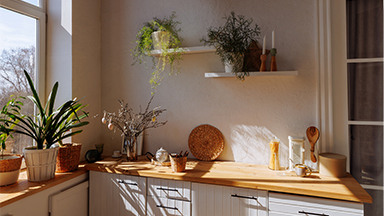Get a $2K LMI rebate for a limited time.
Looking to buy your dream home or investment property, and need a bit extra? AMP Bank is offering a $2K rebate for customers who need to pay lenders mortgage insurance and have less than 20% deposit. Apply by 31 Aug 2024 and settle by 30 Nov 2024. Subject to eligibility criteria.
Find out moreBefore you can step onto the property ladder and buy your first home, you’ll likely have to do some serious saving to build up a deposit. Here are some things to consider that can help get you started, and on the road to home ownership sooner.

Work out your current situation
It might sound obvious, but it’s easier to reach a savings goal when you know where you’re starting from. Understanding your current financial situation – what your income and expenses are – will help you set a budget. You can then track your spending and save a set amount each week, fortnight or month towards your deposit. For tips, check out how to create a budget. You can do it in as little as three steps.
Find out how much you can borrow
Knowing how much you might be able borrow can help you figure out how much home loan deposit you’ll need to save. The AMP borrowing calculator can help with this. Remember though, the amount calculated is only an estimate based on the income and expenses you put in. It’s likely to differ from the amount a lender formally approves you for when the time comes.
It’s also important to remember that interest rates do change, so think about building a buffer into the repayment amount so that you’d still be able to cover your loan repayments if interest rates rise.
Figure out how much deposit you need
Once you know roughly how much you might be able to borrow, compare this with the cost of your ideal property and it can give you a good ballpark figure to aim for. The size of the deposit you need for a home loan is typically 20%. Although in some circumstances it may be possible for home buyers to have as little as a 5% deposit.
Understanding the loan to value ratio and whether you’ll need to pay lenders mortgage insurance can also help you work out how much you can afford to spend when buying a property.
When you’re closer to reaching your house deposit goal, you can speak to a lender about conditional approval for a home loan.
Don’t forget the other upfront costs associated with buying a home such as legal fees, building and pest inspection fees, stamp duty, moving costs and insurances.
Know how long you’ll be saving for
Of course, this all depends on how much you can afford to save each month. But every dollar you can put towards your savings plan means growing a bigger deposit or saving money for less time.
As an example:
| Purchase Price | 20% deposit | Amount saved each month | Number of months to reach deposit goal |
| $300,000 | $60,000 | $2,000 |
30 |
| $500,000 | $100,000 | $2,500 | 40 |
| $700,000 | $140,000 | $3,000 | 47 |
| $1,000,000 | $200,000 | $3,500 | 57 |
Depending on your financial circumstances, a separate savings account for your home loan deposit may be an option you want to consider. It can pay to shop around and find an account that’s right for you, whether it be a regular savings account or a term deposit.
Find out if you’re eligible for first home buyer help
If you’re a first home buyer, you might be eligible for the First Home Owner Grant (FHOG). It’s an Australian state and territory-based scheme that aims to help first home buyers with the cost of purchasing a residential property. Find out more.
Tips to save a deposit faster
- If it’s an option, you might consider temporarily moving back home with your parents, so you can save on rent.
- Free up extra cash by cutting down on unnecessary spending – takeaways, another pair of sunglasses, or monthly subscriptions you don’t use are a good place to start.
- Make additional income by selling things you no longer use or earning money through a side hustle.
- Cut back on food waste and plan your meals so you spend less on groceries.
- Review your utility providers to make sure you have the best deal.
- Defer any big purchases or upgrades like cars or appliances.

Tax time checklist for property investors
17 June 2024 | Blog If you have an investment property, here are some tips to help you prepare at tax time Read more
8 tips to get a harder-working home loan
14 June 2024 | Blog There are many ways you can get your home loan to work harder – from setting up an offset account to reduce the interest you pay, to consolidating your debt. No matter what package you have, you can take control of your repayments and build your financial resilience. Read more
Rising home loan interest rates explained
25 May 2023 | Property Find out all you need to know about rising interest rates plus tips on managing your home loan. Read moreWhat you need to know
The credit provider for all banking products is AMP Bank Limited ABN 15 081 596 009, AFSL and Australian Credit Licence 234517.
Any advice and information is provided is general in nature. It hasn’t taken your financial or personal circumstances into account.
It’s important to consider your particular circumstances and read the relevant product disclosure statement, Target Market Determination or terms and conditions, available from AMP at amp.com.au, or by calling 13 30 30, before deciding what’s right for you. You can also email us at info@ampbanking.com.au.
You can read our Financial Services Guide online for information about our services, including the fees and other benefits that AMP companies and their representatives may receive in relation to products and services provided to you. You can also ask us for a hardcopy.
All information on this website is subject to change without notice.